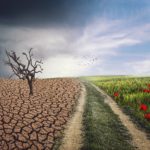 As climate change makes life harder in Mexico, more people are heading north to the United States in search of better conditions, according to a new study from Stanford University. Rising temperatures, severe droughts, and intense storms are forcing Mexican farmers and rural residents to seek new ways to support themselves, leading many to risk undocumented border crossings.
As climate change makes life harder in Mexico, more people are heading north to the United States in search of better conditions, according to a new study from Stanford University. Rising temperatures, severe droughts, and intense storms are forcing Mexican farmers and rural residents to seek new ways to support themselves, leading many to risk undocumented border crossings.
The study focused on Mexico’s agricultural areas, where entire communities depend on seasonal rain. During drought years, people from these regions were more likely to migrate to the U.S. The study also found that once they crossed, fewer people returned home, especially if droughts continued. Migration, then, isn’t just about finding a better life—it’s often about escaping worsening conditions with little hope of returning.
Mexico’s climate problems echo larger, global trends. Fossil fuels, burned worldwide for energy, are driving up temperatures and worsening weather events. Droughts are longer, storms are fiercer, and these conditions make farming far harder in places like Mexico. The country, home to 130 million people, is seeing water shortages and crop failures that threaten rural jobs and food supplies. Scientists predict that, over the next 30 years, 143 million people globally may need to relocate due to climate impacts such as droughts, rising seas, and intense heat.
Measuring movement
To measure these patterns, researchers analyzed weather data and surveyed nearly 50,000 people over 26 years. They looked at the effects of drought and other weather changes in 84 rural communities, particularly during the corn-growing season. People in areas hit by drought were more likely to migrate, and those already in the U.S. were less likely to return home when their communities faced abnormal weather.
Social factors, too, influence who migrates. People from towns with a history of migration were more likely to go, aided by friends and family who could share tips or offer help. And those with slightly better resources were more likely to make the trip in the first place, leaving the poorest often unable to leave despite worsening conditions.
The study points out a growing need for solutions that look beyond border security. As the U.S. tightens border control, it’s harder for migrants to return and risk crossing again. Many end up staying longer than they’d planned, often in low-paying jobs in industries like agriculture and construction—sectors prone to harsh conditions and few protections.
With climate change affecting economies and stability worldwide, experts say the answer isn’t just to focus on the border but to tackle the problems forcing people to migrate in the first place. “We’ve focused so much on border security,” say the researchers. “It’s time to pay attention to why people are leaving—and the economic role they fill once they arrive in the U.S.”